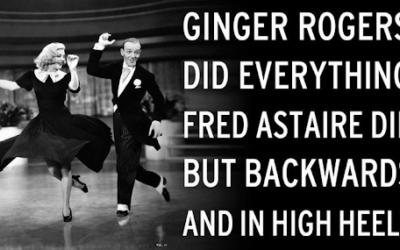Recently, I’ve seen the term “resilience” applied to everything from real estate, to the economy, sports, current events, business, and more. Resilience is a popular buzzword, but what really is resilience? Most people are able to define it as the ability to bounce back from adversity, but few realize that resilience is made up of a number of different skills and abilities. Self-awareness, creating meaning from life lessons, self-efficacy, optimism, and building strong relationships are a few foundational factors that make up resilience.
Even better, there are easy ways people can build more personal resilience – here are seven of them:
- Find satisfaction with your work. People spend over a third of their waking life at work, but levels of work satisfaction vary widely from person to person. Amy Wrzesniewski’s research shows that those who consider their work to be a job are generally interested only in the material benefits from their work and do not seek or receive any other type of reward from it; those who consider their work to be a career have a deeper personal investment in their work and generally seek to advance not only monetarily but also within the occupational structure; and those who consider their work to be a calling usually find that their work is inseparable from their life. Those with a calling work not for financial gain or for career advancement, but for the fulfillment that the work brings. Wrzesniewski explains that those who consider their work to be a calling generally have a stronger and more rewarding relationship to their work. To determine whether your work is a job, career, or a calling, visit www.authentichappiness.org to take Wrzesniewski’s short assessment entitled “Work-Life Questionnaire.”
- Analyze what pushes your buttons. Use this four-step process when you’re curious about a reaction you had, don’t like a reaction you had, or simply want to find a new way of looking at a problem. This technique is based on the work of Drs. Albert Ellis and Aaron Beck, and can help you better understand why your react the way you do to certain situations. First, describe factually what pushed your buttons (who, what, where, when); second, write down your reaction – both what you did and how you felt (I felt angry and yelled); third, write down exactly what you were thinking in-the-moment during the challenge; and fourth, ask yourself whether your reaction helped or hurt your ability to find a solution. People tend to focus only on the reaction part of the equation, but those reactions are driven by how you think; so, if you want to change your reaction to a situation, you need to change the way you think about it.
- Find fun. Kids have zest in abundance, but as we age, societal and organizational pressures quietly tell us that having fun and being serious don’t go together. Not surprisingly, zest is one of the best predictors of work and life satisfaction. In addition, fun helps you socialize, provides an outlet for learning and creativity, and has great health benefits. The Association for Applied and Therapeutic Humor (www.aath.org) posts numerous resources, including research, about the benefits of fun.
- Increase self-awareness by identifying your strengths. Research by Christopher Peterson and his team shows that using your strengths in new ways every day for a week increases happiness and decreases depression. In addition, Harter et al. found that those who get to do what they do best at work on a daily basis have increased loyalty, retention, and productivity.
- Create “THE LIST”. When I was trying to figure out my next career after practicing law, creating “THE LIST” was the one exercise that helped me the most. It helped me reconnect with activities and general pursuits that I’ve always loved to do, but which disappeared in the hustle and bustle of life. To develop THE LIST, set aside some time to reflect on all of the things you’ve loved to do throughout your life. You will start to see patterns throughout your life when you felt great joy performing an activity or impacted someone’s life because of the unique talents you bring to the table. Do more of the activities on THE LIST!
- Build self-efficacy. Remember the children’s book, The Little Engine that Could? The phrase the engine kept saying was, “I think I can, I think I can.” That is self-efficacy – your ability to believe you can accomplish what you want to accomplish. The tendency to remember and only dwell on the times when you’ve failed or done less than your best often thwarts your ability to remember what you’ve accomplished in life. To build your self-efficacy, keep a journal of “wins.” Write down all of the times in your life when you have exceeded expectations, accomplished tough goals, and were in control of your life. Review this list often and keep adding to it. Encourage your kids to start building their list now. In addition, don’t be afraid to start small. Small victories create momentum which is a great foundation from which to succeed at more complicated tasks.
- Help others savor good news. Shelly Gable’s research shows that how you respond to a person’s good news actually does more for building a relationship than how you respond to bad news. This applies across the board from personal relationships to business interactions. Responding in an active and constructive way; that is, helping the bearer of good news savor it, is the only response that builds good relationships. Killing the conversation by offering a terse response or hijacking the conversation by making it about you are quick ways to weaken a relationship.
Building your resilience takes practice, but these simple tools are a good place to start and take so little time. Why not start today?
Take charge of your career development to get the job that supports your work and your life. Check out the tools and resources in the InPower Coaching Career Center.
References
Gable, S.L., Gonzaga, G.C., & Strachman, A. (2006). Will you be there for me when things go
right? Supportive responses to positive event disclosures. Journal of Personality and
Social Psychology, 91(5), 904-917.
—
Harter, J.K., Schmidt, F.L., & Hayes, T.L. (2002). Business-unit-level relationship between
employee satisfaction, employee engagement, and business outcomes: A meta-analysis,
Journal of Applied Psychology, 87, 268-279.
—
Reivich, K., & Shatté, A. (2002). The resilience factor: 7 keys to finding your inner strength
and overcoming life’s hurdles. New York: Broadway Books.
—
Seligman, M.E.P., Steen, T.A., Park, N., & Peterson, C. (2005). Positive psychology progress:
empirical validation of interventions. American Psychologist, 60(5), 410-421.
—
Wrzesniewski, A. (2003). Finding positive meaning in work. In K.S. Cameron, J.E. Dutton, &
R.E. Quinn (Eds.), Positive Organizational Scholarship (pp. 296-308). San Francisco,
CA: Berrett-Koehler Publishers, Inc.






